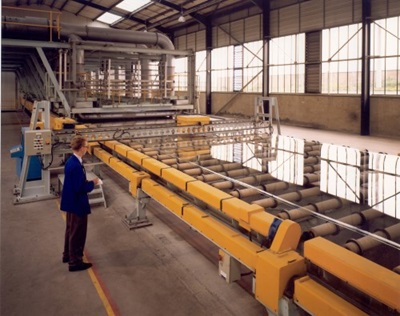Invention of Float Glass
On the 20th January 1959, the Float Glass process was announced to the glass-making world which completely changed the future for glassmaking and the Pilkington company. This process was invented by Sir Alastair Pilkington and his R&D team after seven years of experimenting and investing in the process.
It is often said that Sir Alastair invented the idea of float glass while helping wash the dishes after dinner. He supposedly saw how the oil floated on the surface and thought “what if glass is floated on liquid?”. This romantic idea of a lightbulb lighting up is in fact a myth and Alastair rejected the idea profusely. It is a fact however that Alastair thought about the idea while completing a mindless task and his mind was wondering.
 He began experimenting in December 1952 and though imperfect, he made a flat piece of glass very early in the experimentation stage. However, for this process to reach its full potential and be a success it would have to create a constant flow of high-quality glass 24/7. Creating beyond-industry standard glass 24/7 would give Pilkington a huge advantage over any competition at the time. All pieces of glass which were made by the process between 1952 and 1959 were not perfect, which made the honing of this process so long and gruelling.
He began experimenting in December 1952 and though imperfect, he made a flat piece of glass very early in the experimentation stage. However, for this process to reach its full potential and be a success it would have to create a constant flow of high-quality glass 24/7. Creating beyond-industry standard glass 24/7 would give Pilkington a huge advantage over any competition at the time. All pieces of glass which were made by the process between 1952 and 1959 were not perfect, which made the honing of this process so long and gruelling.
In 1955, Pilkington formally decided to build float process machines and after seven years of effort and £28 million (approximately £150 million in today’s money*) in R&D expenses, a sheet of glass made entirely by the float process was produced in July 1958.
In 1959 Pilkington announced this cutting-edge process to the glass-making world and licenced out the rights to use this process. This decision has been widely disputed and, in many opinions, considered controversial due to Pilkington giving away a prime spot in the market and not taking advantage of a monopoly situation.
There are now around 500 glass float lines in the world and the float process is considered the world standard for high quality glass manufacture.
*Calculated using Bank of England’s inflation online calculator
Information sourced from The Glassmakers by T. C. Barker and Float: Pilkingtons' Glass Revolution by D. J. Bricknell and in-house.